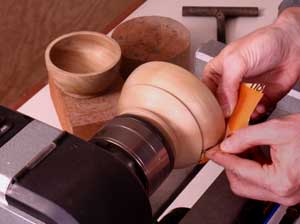
I’m just starting to get into lathe turning. With the multiple speeds on the lathe, at which speed is it best to sand finish the project? It seems to me that at the lower speeds, the sand paper doesn’t clog up as fast. – Robert Cornelisse
Tim Inman: Turning has had a special place in my heart since I was a 10-year-old boy; I’m still fascinated with it. Turning is truly one of the “ancient” crafts. Thus there are lots of “rules” and many experts with advice on the topic. One of the best rules I was ever taught came to me from a man in England who is the best turner I ever met, and probably the dean of turners in the world today, Bill Jones When asked which tool he used to do a certain job, he replied, “The one that cuts.” Take that lesson from the master, and use it to answer your own question. In other words, use the speed that works best for your sanding job. I generally prefer to err on the slower side when I work at my lathes. Many others prefer higher rpm’s. In the end, it is the quality of the work that tells the tales, and discussions about rpm should follow, not lead. Different woods, different sizes, different abrasives – different operators! – all make a difference. Use the speed you like that works best. More speed means more heat, and heat is often the enemy, especially sanding.
Chris Marshall: Take your time with sanding, too, and follow the same routine you’d use with other projects. Start with coarser grits and move up to finer ones, regardless of what speed you use on your lathe. Don’t make the spinning action a substitute for methodical sanding. When the paper loads up and loses its effectiveness, grab a fresh piece—I tend to go through a lot of it! Whether you’re sanding on the lathe or at the bench, it’s always a process of replacing larger scratches with smaller ones until you reach a point that you can’t see or feel them anymore.





